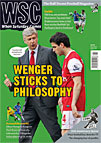 Peter Bateman recalls the 1965-66 season when Liverpool and Everton both had campaigns to remember
Peter Bateman recalls the 1965-66 season when Liverpool and Everton both had campaigns to remember
The long-term significance
This season confirmed the shift in football’s balance of power northwards. The Championship trophy went to Merseyside for the third time in four seasons and the FA Cup for the second season running. Liverpool also reached their first European final. Leeds Utd established themselves as a force in the game while Manchester Utd had a rare trophyless season in between Championships.
The Lancashire town clubs, who had enjoyed success in the previous decade, were now in evident decline. Blackburn’s relegation followed that of Preston and Bolton in previous seasons.
Story of the season
Liverpool won the Championship for the second time in three years, finishing six points clear of Leeds. Their dominance was based on form at Anfield where they only dropped six points all season. They also reached the final of the Cup-Winners Cup in which they lost 2-1 to Borussia Dortmund. Leeds, promoted in 1964, were runners-up for the second year in a row. Burnley’s third place was to prove an Indian summer for the 1960 Champions.
The main attraction for neutrals was following the fortunes of Northampton Town, who were making an improbable debut in Division One after three promotions in five years. The Cobblers failed to win any of their first 14 games and looked hopelessly out of their depth. They recovered well in the second half of the season, however, and relegation was only confirmed after the penultimate home game, a 4-2 defeat against Fulham whom they had earlier beaten 4-1 at Craven Cottage. Blackburn’s season, on the other hand, was an unmitigated disaster. Their start having been delayed by an outbreak of polio in the town, they were in the bottom two all season, losing 30 matches – including 15 of the last 17.
Fleet Street pundits rejoiced when the FA Cup semi-final draw kept Manchester Utd and Chelsea apart. Their “dream final” did not, however, materialise. Contrary to expectations, Everton and Sheffield Wednesday produced one of the best post-war finals. Wednesday led 2-0 after an hour but Everton came back to win 3-2, their first two goals scored by the previously obscure Cornishman Mike Trebilcock.
The League Cup was still struggling to shake off the tag of “Hardaker’s folly” and some leading clubs either did not enter or did not treat it as a priority. One new entrant this season was West Bromwich Albion who duly won it, defeating West Ham 5-3 in the last two-legged final. Elsewhere in the West Midlands football was in the doldrums. Aston Villa had another mediocre season amid growing supporter apathy – only 10,438 watched their home defeat against Northampton.
For the record books
Burnley’s Willie Irvine was the division’s top scorer with 29 goals. Northampton’s Barry Lines became the first player to score for the same club in all four divisions. Liverpool set a League record in using only 14 players – a feat matched by Aston Villa in 1980-81.
Same place today
While 15 of these clubs are currently in the Premier League, only Liverpool, Everton and Arsenal have unbroken membership of the top flight since 1966. Blackpool, Blackburn, Fulham and Stoke have all experienced absences of more than 20 years with Blackburn and Stoke dropping to the third tier, and Fulham and Blackpool to the fourth.
Moved furthest away
Northampton’s descent down the League was even more rapid than their ascent, and they ended the decade where they had started, in Division Four. They have not been higher than the third tier since 1967 and are currently in League Two.
Of the other clubs, Sheffield Wednesday are currently in League One while Burnley, Nottingham Forest, Leeds, Leicester and Sheffield Utd are in the Championship.
From WSC 291 May 2011